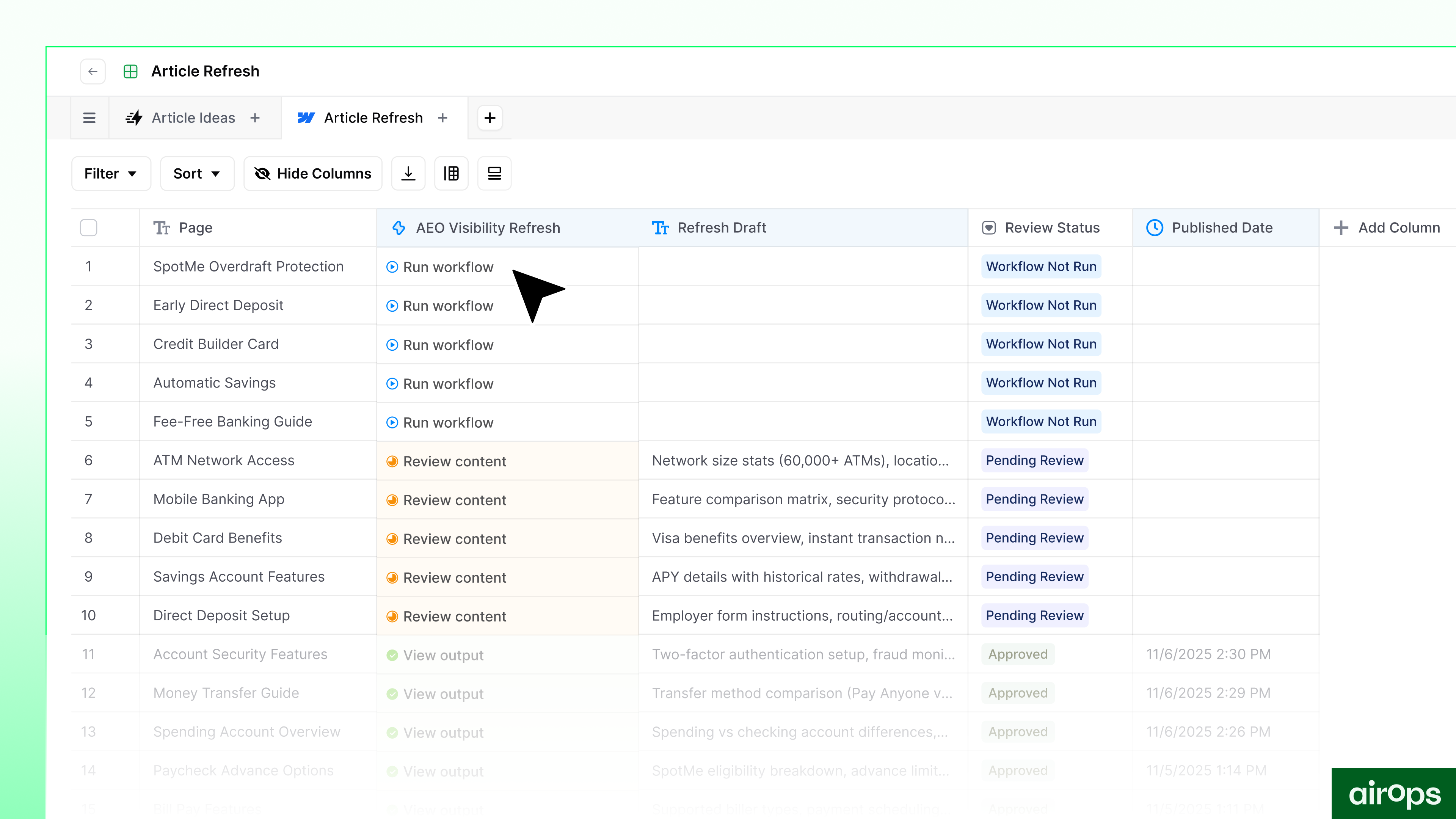Content Refresh Templates That Drive 70% Faster Search Wins

- Use clear, reusable templates so refreshes stop feeling like firefighting and cut refresh time by up to 70%.
- Set up alerts and light automation to spot slipping pages early, before traffic dips or competitors pass you.
- Create tailored templates for product pages, blog posts, and resource guides so each gets the right kind of update.
- Link refresh work to real outcomes like leads, sign-ups, and revenue so it’s easy to show value and keep support.
While you’re busy publishing new pieces, older pages can quietly lose steam and traffic. In fact, 96% of pages get no Google visits often because they aren’t kept up to date. Without a simple, repeatable refresh plan, teams burn time on manual audits and still miss chances to improve.
Below, you'll find plug-and-play templates and refresh playbooks you can copy. You’ll learn how to spot pages that need attention, build reusable templates, and run your refresh program at scale. We’ll cover what works for classic SEO and what helps you show up in AI answers, too.
Why Are Content Refreshes Important?
Great content refresh templates are simple, repeatable, and easy for the whole team to run. Their job is to help you spot what’s slipping, choose what to fix first, and update pages without reinventing the wheel. The best setups mix light automation, step-by-step checklists, and a clear goal for what success looks like.
According to AirOps research, more than 70% of pages earning citations and visibility in ChatGPT were updated within the past 12 months—freshness is now table stakes for AI visibility.
When refresh work is haphazard, teams end up:
- Discovering declines too late
- Doing manual audits that take weeks
- Wasting time rewriting pages from scratch
- Missing easy wins sitting in their archive
How Do I Create Templates for Content Refreshes?
Great templates make refreshes faster, more consistent, and easier for anyone on your team to run. A strong template removes guesswork and keeps updates focused on what actually moves rankings and citations.
1. Content audit spreadsheet
Track URL basics like last update, traffic trend, and rankings. This is how you spot decay early. You can also get a complete performance picture in AirOps, including a single view with smart filters and direct paths to pre-built workflows to take action on content opportunities.
2. Prioritization scorecard
Rank pages by impact, upside, and effort so you’re refreshing the right pages first.
3. Update checklist
Clear, step-by-step tasks for every refresh, such as:
- Refresh stats and examples
- Align structure to search intent
- Tighten internal linking
- Fix outdated sections
- Improve schema
- Strengthen CTAs
With these in place, refreshes stop being fire drills and start becoming routine tune-ups. Start with one template, prove its value, then build variations for blog posts, product pages, comparison pages, and guides.
Learn more about Insights in AirOps.
.png)
According to Google Search Central, Google has "query deserves freshness" systems designed to show fresher content for queries where it would be expected.
Your templates should flag time-sensitive pages (statistics, pricing, trends) for more frequent updates so they continue to match evolving queries. Aligning update cadence with searcher expectations helps preserve rankings and click-through.
How Do I Spot Pages That Need Refreshing?
Most teams spot decay only after traffic drops. That’s too late.
Set up light automated monitoring for:
- Ranking declines
- CTR drops
- Competitor page updates
- Outdated data on your page
- Search intent shifts
- New SERP features you’re not matching
This replaces manual audits with always-on detection.
How Do I Prioritize Which Pages to Refresh?
Not every page deserves immediate attention. Use a scoring system based on:
- Current traffic and conversions
- Strategic value (product, pricing, competitive)
- Upside (queries with rising demand)
- Effort required (light vs. heavy lift)
Once you've seen your current performance, you can take action on those to begin the refresh process for your highest-leverage opportunities.

How Do I Build Refresh Frameworks that Deliver Results?
Strong content refresh frameworks pair automation with human judgment so you move fast without sacrificing quality. Set yours to spot early signs of decay and give your team a clear path to ship updates quickly.
Here’s the model:
1. Automate discovery
Alerts surface slipping pages before they lose momentum.
2. Use templates by content type
Product pages need different updates than blog posts or guides.
3. Set a refresh cadence
- Quarterly: high-traffic and stats-heavy pages
- Semi-annual: product pages, comparisons, features
- Yearly: evergreen deep dives
4. Tie work to results
Track what changed, what you updated, and the outcome.
According to Gartner, CMOs report GenAI investments are delivering ROI through improved time efficiency (49%) and cost efficiency (40%), with leaders using AI and analytics to boost productivity amid flat budgets.
This is where automation plus templates really pays off. It turns routine upkeep into clear efficiency gains you can reinvest in high-impact improvements. Docebo is a good example. They had a 2x increase in content velocity with the team now refreshing up to 25 pages per month. With clear templates and light automation, they turned refresh from a heavy lift into a steady, results-driven practice.
Takeaways
These frameworks turn refresh work from a chore into a simple, repeatable habit.
- Reusable templates cut refresh time by up to 70% and keep quality consistent across the board.
- Lightweight alerts flag slipping pages early—before drops dent traffic or conversions.
- Page‑type playbooks (product, blog, guides) make sure each one gets the right kind of tune‑up.
- Tie updates to real outcomes—sign‑ups, pipeline, revenue—so it’s easy to show what’s working.
- Regular cadences stop decay and help you show up in both classic search and AI answers.
Yes, there’s a bit of setup. But it compounds fast: better rankings and steadier visibility. Start with one high‑impact template, prove it, then roll it out to more page types. Teams that audit their content strategically are set up to win in both traditional search and AI results.
Improve Your Content Refreshes with AirOps
Manual refreshes burn time, and pages slip. AirOps automates the whole loop—from spotting decay to shipping updates—so you stay visible in search and AI answers.
- Refresh existing content with automated workflows that update stats, improve structure, and keep brand voice aligned.
- Catch ranking dips and competitor moves early with always‑on monitoring.
- Ship updates up to 5x faster with templates and guardrails that protect quality.
Book a call to learn how AirOps can transform your content refresh operations into a competitive advantage.
Win AI Search.
Increase brand visibility across AI search and Google with the only platform taking you from insights to action.
Get the latest on AI content & marketing
Get the latest in growth and AI workflows delivered to your inbox each week



.avif)

